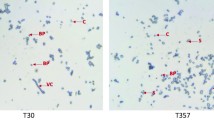Abstract
A bacterial isolate (Mm2) ofMelolontha melolontha was identified and characterized. Based on various morphological, physiological, biochemical and molecular characteristics, it was identified asBacillus thuringiensis subsp.tenebrionis. This isolate was compared to the reference strains by electron microscopy, SDS-PAGE analysis, plasmid pattern,cry gene content and insecticidal activity. Cells of the isolate harbored flat square inclusions containing a protein component of ≈65 kDa. After trypsin digestion of solubilized crystals, SDS-PAGE resolved a unique proteinase-resistant peptide of ≈50 kDa. Plasmid pattern showed similar bands to those of the reference strain, PCR analysis showed that the isolate hascry3 gene. Toxicity tests (against 5 coleopteran species) showed 80 % insecticidal activity against the larvae ofM. melolontha. The isolate Mm2 may be valuable as biological control agent forM. melolontha and other coleopteran insects.
Similar content being viewed by others
Abbreviations
- PCR:
-
polymerase chain reaction
- SDS-PAGE:
-
sodium dodecyl sulfate-polyacrylamide gel electrophoresis
- SCM:
-
spore-crystal mixture
References
Becker N., Margalit J.: Use ofBacillus thuringiensis israelensis against mosquitoes and blackflies, pp. 145–170 in P.F. Entwistle, P.F. Cory, M.J. Bailey, S. Higgs (Eds): Bacillus thuringiensis,an Environmental Pesticide: Theory and Practice. John Wiley & Sons, New York 1993.
Ben-Dov E., Zaritsky A., Dahan E., Barak Z., Sinai R., Manasherob R., Khameraev A., Troitskaya E., Dubitsky A., Berezina N., Margalith Y.: Extended screening by PCR for sevencry-group genes from field-collected strains ofBacillus thuringiensis.Appl.Environ.Microbiol. 63, 4883–4890 (1997).
Bietlot H.P.L., Vishnubhatla I., Carey P.R., Pozsgay M., Kaplan H.: Characterization of the cysteine residues and disulphide linkages in the protein crystal ofB. thuringiensis.J.Biochem. 267, 309–315 (1990).
Bucher G.E.: Identification of bacteria found in insect, pp. 10–30 in H.D. Burges (Ed.):Microbial Control of Pest and Plant Diseases. Academic Press, London 1981.
Damgaard P.H., Hansen B.M., Pedersen J.C., Eilenberg J.: Natural occurrence ofBacillus thuringiensis on cabbage foliage and in insects associated with cabbage crops.J.Appl.Microbiol. 82, 253–258 (1997).
Dean D.H., Zeigler D.R.: BacillusGenetic Stock Center Strains and Data, 6th ed. Ohio State University Press, Columbus 1994.
Feitelson J.S., Payne J., Kim L.:Bacillus thuringiensis: insects and beyond.Biotechnology 10, 271–275 (1992).
Froschle M.V.: The common cockchafer (Melolontha melolontha L.) has to be taken seriously again in Baden-Württemberg.Pflanzenschutzdienstes 46, 6–9 (1994).
Gonzales J.M.J., Dulmage H.T., Carlton B.C.: Correlation between specific plasmids and δ-endotoxin production inBacillus thuringiensis.Plasmid 5, 351–365 (1981).
Höfte H., Whiteley H.R.: Insecticidal crystal proteins ofBacillus thuringiensis.Microbiol.Rev. 53, 242–255 (1989).
Honigman A., Nedjar-Pazerin G., Yawetz A., Oron U., Schuster S., Broza M., Snek B.: Cloning and expression of the lepidopteran toxin produced byBacillus thuringiensis inEscherichia coli.Gene 42, 69–77 (1986).
Iriarte J., Dumanoir V.C., Bel Y., Porcar M., Ferrandis M.D., Lecadet M.M., Ferre J., Caballero P.: Characterization ofBacillus thuringiensis ser.balearica (serotype H48) and ser.navarrensis (serotype 50): two novel serovars isolated in Spain.Curr.Microbiol. 40, 17–22 (2000).
Ishiwata S.: On a kind of severe flacherie (sotto disease).Dainihon Sanshi Kaiho 114, 1–5 (1901).
Kati H., Sezen K., Beldüz A.O., Demirbağ Z.: Characterization of aBacillus thuringiensis subsp.kurstaki strain isolated fromMalacosoma neustria L. (Lepidoptera: Lasiocampidae).Biologia 60, 301–305 (2005).
Krieg N.R., Holt J.G.: Gram-negative aerobic rods and cocci, pp. 140–218 in N.J. Palleroni (Ed.):Bergey’s Manual of Systematic Bacteriology. Williams & Wilkins, Baltimore 1986.
Kronstad J.W., Schnepf H.E., Whiteley H.R.: Diversity of locations forBacillus thuringiensis crystal protein genes.J.Bacteriol. 154, 419–428 (1983).
Laemmli U.K.: Cleavage of structural proteins during the assembly of the head of bacteriophage T4.Nature 227, 680–685 (1970).
Lee H.H., Joo D.G., Kang S.C., Lim H.G.: Characterization ofB. thuringiensis seven isolates from soil (I).Korean J.Appl.Microbiol. Biotechnol. 20, 377–388 (1992).
Lee H.H., Jung J.D., Yoon M.S., Lee K.K., Lecadet M.M., Charles J.F., Dumanoir V.C., Franchon E., Shim J.C.: Distribution ofBacillus thuringiensis in Korea. B.thuringiensisBiotechnol.Environ.Benefits 1, 201–215 (1995).
Lereclus D., Delecluse A., Lecadet M.M.: Diversity ofBacillus thuringiensis toxins and genes, pp. 37–70 in P.F. Entwistle, J.S. Cory, M. Bailey, S. Higgs (Eds): Bacillus thuringiensis,an Environmental Biopesticide: Theory and Practice. Chichester-John Wiley, New York 1993.
Luisa M., Mauro V.: Presence and diffusion of the common cockchafer (Melolontha melolontha L.) in the areas of Mezzocorona and San Michele a/A in Trento Province.Bulletin OILB SROP 19, 15–20 (1996).
Minitab: User’s Guide, Release 11. Minitab-State College Pennsylvania (USA) 1997;http://www.minitab.com.
Ohba M., Aizawa K.: Distribution ofBacillus thuringiensis in soil of Japan.J.Invertebr.Pathol. 47, 277–286 (1986).
Peferoen M.: Insect control with transgenic plants expressingBacillus thuringiensis crystal proteins, pp. 21–48 in N. Carozzi, M. Koziel (Eds):Advances in Insect Control, the Role of Transgenic Plants. Taylor and Francis, Bristol (USA) 1997.
Sambrook J., Fritsch E.F., Maniatis T.:Molecular Cloning, 2nd ed. Cold Spring Harbor Laboratory Press, Cold Spring Harbor 1989.
Sezen K.: Determination of viruses from coleopteran pests of hazelnut and the potential usage as biological control agent.PhD Thesis. Department of Biology, Karadeniz Technical University, Graduate School of Natural and Applied Sciences, Trabzon (Turkey) 2004.
Sezen K., Demirbağ Z.: Isolation and insecticidal activity of some bacteria from the hazelnut beetle (Balaninus nucum L.).Appl.Entomol.Zool. 34, 85–89 (1999).
Sharif F.A., Alaeddinoğlu N.G.: A rapid and simple method for staining of the crystal protein ofBacillus thuringiensis.J.Industr.Microbiol. 3, 227–229 (1988).
Sneath P.H.A., Mair N.S., Sharpe M.E., Holt J.G.: Regular, nonsporing Gram-positive rods, pp. 1208–1260 in O. Kandler, N. Weiss (Eds):Bergey’s Manual of Systematic Bacteriology. Williams & Wilkins, Baltimore 1986.
Tamez-Guerra P., Castro-Franco R., Medrano-Roldan H., McGuire M.R., Galan-Wong L.J., Luna-Olvera H.A.: Laboratory and field comparisons of strains ofBacillus thuringiensis for activity against noctuid larvae using granular formulations (Lepidoptera).J.Econ.Entomol. 91, 86–93 (1998).
Thiery I., Frachon E.: Identification, isolation, culture and preservation of entomopathogenic bacteria, pp. 55–73 in A.L. Lacey (Ed.):Manual of Techniques in Insect Pathology. Academic Press, London 1997.
Vlug H.J.: Occurrence and biocontrol of grass grubs, especially ofM. melolontha.Bull.OILB SROP 19, 35–36 (1996).
Author information
Authors and Affiliations
Corresponding author
Additional information
This work was supported by theKaradeniz Technical University research foundation (KTU 21.111.004.4) andTurkish Republic Prime Ministry State Planning Organization (21.111.004.1).
Rights and permissions
About this article
Cite this article
Kati, H., Sezen, K. & Demirbağ, Z. Characterization of a highly pathogenicBacillus thuringiensis strain isolated from common cockchafer,Melolontha melolontha . Folia Microbiol 52, 146–152 (2007). https://doi.org/10.1007/BF02932153
Received:
Revised:
Issue Date:
DOI: https://doi.org/10.1007/BF02932153




